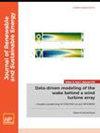用于风力涡轮机系统最大功率提取的自适应分数反步智能控制器
IF 1.9
4区 工程技术
Q4 ENERGY & FUELS
引用次数: 0
摘要
然而,风力发电厂的控制是一个具有挑战性的问题。这是因为风力发电厂具有高度非线性动态特性、未知干扰、参数不确定性以及风速曲线的快速变化。因此,需要鲁棒控制器来克服这些挑战。本文针对基于双馈感应发电机的风力涡轮机提出了两种新型控制方法。其主要目标是调节发电机速度和转子电流。本文提出了一种基于径向基函数(RBF)神经网络扰动观测器的分数阶反步滑模控制(SMC)来控制转子电流。这种基于 RBF 神经网络的扰动观测器能估计未知扰动。此外,还提出了一种新的自适应分数阶终端 SMC,用于控制发电机转速。在 SMC 设计中,采用了不需要任何不确定性分数微积分约束信息的鲁棒无颤振控制器,以消除不希望出现的颤振现象。控制器参数利用蚁群优化算法进行优化调整。通过对各种条件的仿真研究,对所提出的方法进行了验证。此外,还将其性能与传统的反步态控制器和传统的反步态滑模控制器进行了比较。仿真结果验证了该方法能够最大限度地提取风能,并适当调节转子电流。与其他两种方法相比,拟议方法的跟踪误差减少了约 20%,这意味着效率提高了 20%。本文章由计算机程序翻译,如有差异,请以英文原文为准。
Adaptive fractional backstepping intelligent controller for maximum power extraction of a wind turbine system
Controlling wind power plants is a challenging issue, however. This is due to its highly nonlinear dynamics, unknown disturbances, parameter uncertainties, and quick variations in the wind speed profiles. So robust controllers are needed to overcome these challenges. This paper suggests two novel control approaches for doubly fed induction generator-based wind turbines. Its key objective is to regulate the generator speed and rotor currents. A radial basis function (RBF) neural network disturbance observer based fractional order backstepping sliding mode control (SMC) is presented to control the rotor currents. This RBF neural network-based disturbance observer estimates unknown disturbances. Also, a new adaptive fractional order terminal SMC is suggested for the control of the generator speed. This robust chattering-free controller that does not require any information about the bound of uncertainties fractional calculus is adopted in the SMC design to eliminate undesired chattering phenomena. The controller parameters are optimally tuned utilizing the ant colony optimization algorithm. The proposed approach was validated using a simulation study entailing various conditions. Its performance was also compared to that of the conventional backstepping and conventional backstepping sliding mode controller. The simulations results verified the approach's ability to maximize power extraction from the wind and properly regulate the rotor currents. The proposed method has about 20% less tracking error than the other two methods, which means 20% higher efficiency.
求助全文
通过发布文献求助,成功后即可免费获取论文全文。
去求助
来源期刊

Journal of Renewable and Sustainable Energy
ENERGY & FUELS-ENERGY & FUELS
CiteScore
4.30
自引率
12.00%
发文量
122
审稿时长
4.2 months
期刊介绍:
The Journal of Renewable and Sustainable Energy (JRSE) is an interdisciplinary, peer-reviewed journal covering all areas of renewable and sustainable energy relevant to the physical science and engineering communities. The interdisciplinary approach of the publication ensures that the editors draw from researchers worldwide in a diverse range of fields.
Topics covered include:
Renewable energy economics and policy
Renewable energy resource assessment
Solar energy: photovoltaics, solar thermal energy, solar energy for fuels
Wind energy: wind farms, rotors and blades, on- and offshore wind conditions, aerodynamics, fluid dynamics
Bioenergy: biofuels, biomass conversion, artificial photosynthesis
Distributed energy generation: rooftop PV, distributed fuel cells, distributed wind, micro-hydrogen power generation
Power distribution & systems modeling: power electronics and controls, smart grid
Energy efficient buildings: smart windows, PV, wind, power management
Energy conversion: flexoelectric, piezoelectric, thermoelectric, other technologies
Energy storage: batteries, supercapacitors, hydrogen storage, other fuels
Fuel cells: proton exchange membrane cells, solid oxide cells, hybrid fuel cells, other
Marine and hydroelectric energy: dams, tides, waves, other
Transportation: alternative vehicle technologies, plug-in technologies, other
Geothermal energy
 求助内容:
求助内容: 应助结果提醒方式:
应助结果提醒方式:


